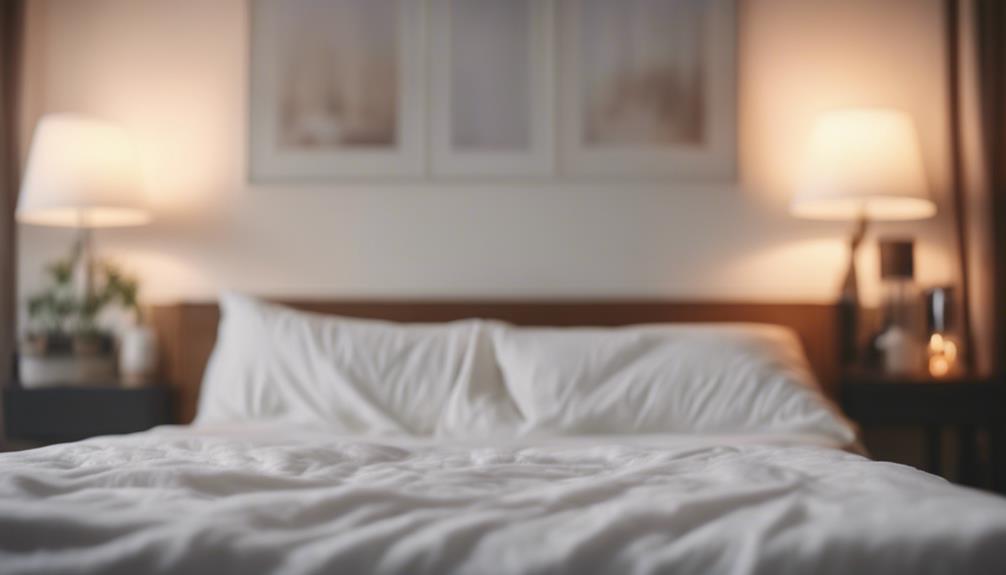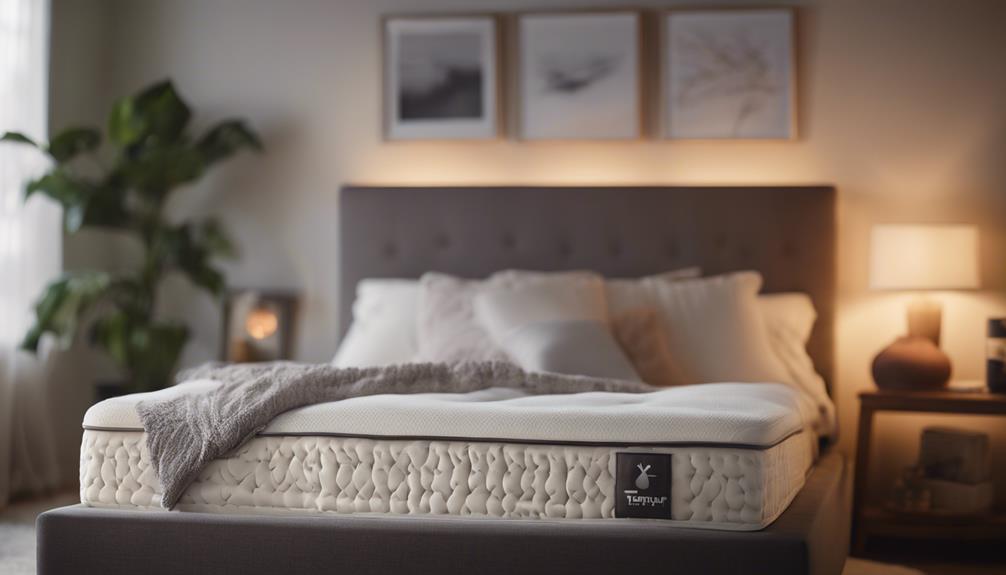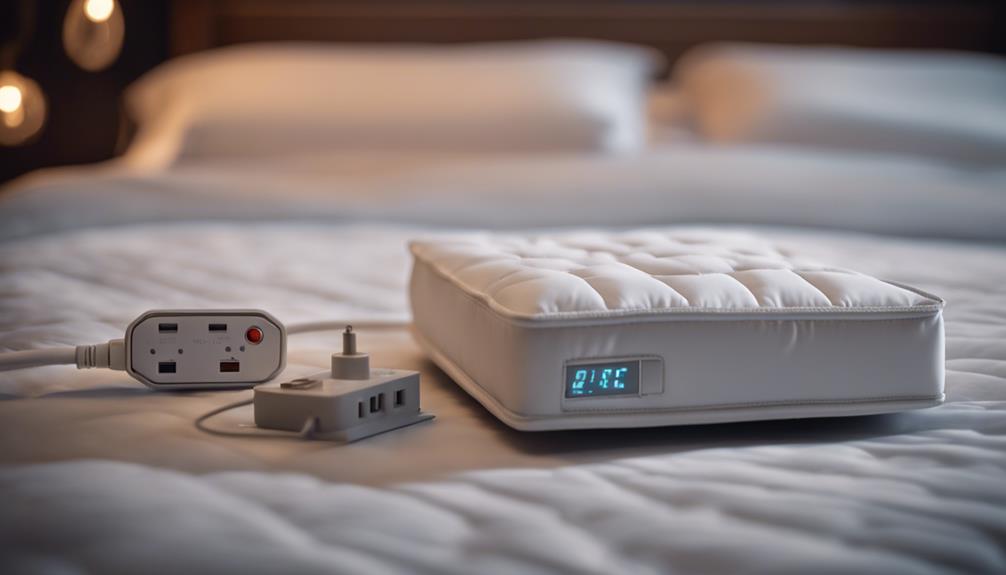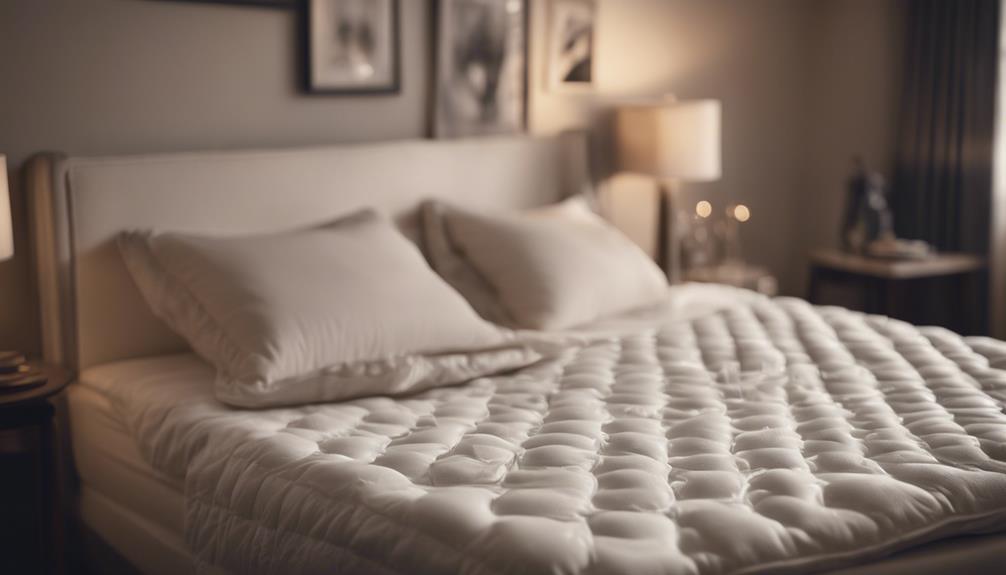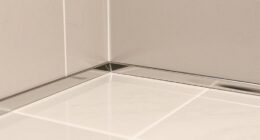If your mattress pad keeps sliding around, the problem could be due to a lack of friction with your mattress cover. Smooth covers that don’t have enough grip can cause the pad to move. Choose textured covers that provide better traction. Additionally, not having a headboard or footboard can also result in shifting. Ensure your topper is the right size to prevent movement. An unstable bed frame can also be a contributing factor. Consider using preventive measures such as using a tight-fitted sheet or a non-skid mat. These steps can assist in keeping your mattress pad in place all through the night.
Key Takeaways
- Lack of friction on mattress cover causes pad movement.
- Absence of headboard or footboard leads to instability.
- Using the wrong size topper results in shifting.
- Unstable base like a bed frame contributes to pad movement.
- Old mattress decreases stability and support, causing pad movement.
Lack of Friction on Mattress Cover

When selecting a mattress cover, prioritize choosing one with sufficient grip to prevent your mattress pad from shifting. A smooth mattress cover lacking friction can cause your mattress pad to move around, leading to discomfort and disrupting your sleep.
Frictionless surfaces make it easy for the pad to shift out of place, causing a lack of support where you need it most. To combat this issue, opt for a cover with more grip or texture. Textured covers provide the necessary friction to keep your mattress pad in position, preventing displacement during the night.
Without adequate grip, the mattress pad may slide due to the lack of resistance on the smooth surface, leading to constant readjustments and potential discomfort. By selecting a cover that offers better traction, you can secure a more stable and comfortable sleeping surface.
Absence of Headboard or Footboard

To prevent mattress pad movement, consider the impact of an absence of headboard or footboard, as these components act as stabilizers to keep the pad in place. Minimalist bed frames, popular for their sleek design, often lack these stabilizing elements, leading to increased movement of the mattress pad.
The headboard and footboard not only provide additional support to prevent sliding but also help reduce the displacement of the pad during sleep. By incorporating these components into your bed frame, you can enjoy a bed that stays neatly made without the constant need for readjustment due to the pad slipping out of place.
Investing in a headboard or footboard can greatly enhance the sleeping experience by ensuring reduced sliding of the mattress pad, allowing you to rest undisturbed throughout the night.
Using the Wrong Size Topper

Selecting an ill-fitting topper can lead to unwarranted shifting and discomfort during sleep. When the mattress pad doesn't match the bed's dimensions, it can result in unwanted movements.
If the topper is larger than the mattress, it may shift more easily, causing sliding during the night. On the other hand, a topper smaller than the bed creates an uneven surface, increasing the chances of shifting and lack of surface stability.
An improper size match between the mattress and topper can lead to an unstable surface, reducing overall stability. Ensuring proper sizing is essential for the topper to stay in place and provide excellent comfort.
Unstable Base Like Bed Frame

An unstable bed frame can be the culprit behind a shift-prone mattress pad. When the base lacks stability, the mattress pad is more likely to move around and cause discomfort.
Ensuring a secure and sturdy bed frame can help keep your mattress pad in place for a restful night's sleep.
Uneven Bed Frame
When dealing with an uneven bed frame, it's important to address the instability it causes for your mattress pad's position and movement. To stabilize your mattress pad on an uneven bed frame, consider the following:
- Adjust the legs: Make sure the legs of your bed frame are properly adjusted to maintain a level surface for your mattress pad.
- Use a non-slip mat or rug: Placing a non-slip mat or rug under the mattress pad can help stabilize it on the uneven bed frame.
- Maintain stability: A stable and level bed frame is crucial to prevent your mattress pad from shifting and moving during use.
Shifting Mattress Pad
To guarantee your mattress pad from shifting due to an unstable base like a bed frame, securing it with a non-skid mat or tape can effectively anchor it in place. An unsteady bed frame can lead to the mattress pad moving around during the night, causing discomfort and disturbance.
Poor quality mattresses can exacerbate this issue, increasing the likelihood of unwanted shifts. Using a mattress pad that doesn't fit your bed size can also create an uneven surface, promoting movement.
Additionally, a lack of friction from a smooth mattress cover can contribute to the pad sliding. By investing in a non-skid mat or using tape to secure the mattress pad, you can enhance stability and ensure a restful night's sleep.
Old Mattress

Experiencing a worn-out mattress can greatly contribute to the movement of your mattress pad. When your mattress gets old, it can lead to a range of issues affecting its support and stability, which in turn can cause your mattress pad to shift and slide. Here are some key points to ponder regarding an old mattress and its impact on your mattress pad:
- Decreased Support: An old mattress tends to lose its firmness and shape over time, making it challenging for the mattress pad to stay in place.
- Lack of Stability: The diminishing support from an old mattress can result in the mattress pad shifting and sliding during the night, disrupting your sleep quality.
- Consider Upgrading: If your mattress is showing signs of wear and tear, upgrading to a new mattress can provide better support, prevent movement, and enhance your overall sleep experience.
Investing in a new mattress can address the issue of your mattress pad moving, ensuring a more comfortable and stable sleep surface.
Preventive Measures for Pad Movement

To prevent your mattress pad from moving during the night, consider implementing these essential measures. Using a tight fitted sheet can help secure the pad in place, preventing it from shifting around. Employing sheet straps or clips is another excellent way to keep the pad in position and avoid any unwanted movement.
For added stability, you may also want to think about placing a non-skid mat or rug underneath the mattress pad. Additionally, applying tape or adhesive strips to anchor the pad to the mattress can help minimize any sliding during the night.
Ensuring a stable base with a bed frame or foundation is vital in preventing your mattress pad from moving around while you sleep. By incorporating these preventive measures, you can enjoy a more comfortable and undisturbed night's rest knowing that your mattress pad will stay in place.
Frequently Asked Questions
How Do I Keep My Mattress Topper From Moving?
To keep your mattress topper from moving, try tight fitted sheets or sheet straps. You could also consider a velcro system or non-slip mat for extra grip. Safety pins are a budget-friendly solution. Look for toppers with features like MicroGrip® technology.
Make sure your topper is the right size and sits on a stable base. These tips should help prevent your mattress topper from shifting around during the night.
How Can I Stop My Mattress From Sliding?
To guarantee your mattress from sliding, try using a tight fitted sheet or sheet straps for a secure hold. Consider options like a velcro system, non-skid mat, or carpet tape for added grip. Safety pins can also be a budget-friendly solution.
Look for features like MicroGrip® technology in mattress toppers for anti-sliding benefits. Make sure the right sizing and a stable base to keep your mattress in place for a comfortable sleep.
How to Keep a Mattress Pad From Bunching?
To maintain a mattress pad from bunching, guarantee a snug fit with deep pocket covers or anchor bands. A non-slip pad underneath adds stability. Regular adjustments prevent bunching over time.
Avoid high heat when washing to prevent shrinkage. These steps preserve pad position and comfort for better sleep.
Does the Bumpy Side of a Mattress Pad Go up or Down?
When setting up a mattress pad, it's important to position the bumpy side down towards the mattress for enhanced stability and grip. This orientation prevents the pad from shifting during sleep.
The smooth side, facing up, offers comfort and softness. The textured underside of the pad helps it adhere securely to the mattress surface.
Conclusion
So, if you're wondering why your mattress pad keeps shifting around, it may be due to a lack of friction on the mattress cover, not having a headboard or footboard to anchor it, using the wrong size topper, having an unstable bed frame, or simply having an old mattress.
By taking preventive measures like using non-slip pads or straps, you can guarantee your mattress pad stays in place for a comfortable night's sleep.
Just ask Sarah, who finally solved her pad movement issue by securing it with adjustable straps.


